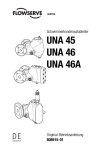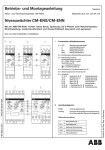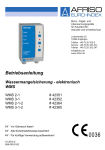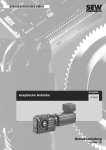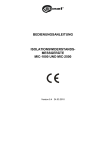Download NRG 16-38S NRG 16-39S
Transcript
GESTRA GESTRA Steam Systems NRG 16-38S NRG 16-39S Betriebsanleitung 808530-05 DE Deutsch EN English Niveauelektrode NRG 16-38S Niveauelektrode NRG 16-39S Installation & Operating Instructions 808530-05 Level Electrode NRG 16-38S Level Electrode NRG 16-39S 1 Diese Seite bleibt absichtlich frei. This page is intentionally left blank. 2 Deutsch DE Seite................................................................................................................................................4 – 24 English EN Page..............................................................................................................................................26 – 47 3 Inhalt DE Seite Einsatz Bestimmungsgemäßer Gebrauch.............................................................................................................6 Funktion..................................................................................................................................................6 Technische Daten NRG 16-38 S, NRG 16-39S.................................................................................................................7 – 8 Verpackungsinhalt...................................................................................................................................8 Typenschild / Kennzeichnung...................................................................................................................9 Maße NRG 16-38 S, NRG 16-39 S...........................................................................................................10 Wichtige Hinweise Sicherheitshinweis.................................................................................................................................11 Einbau NRG 16-38 S, NRG 16-39S.....................................................................................................................12 Legende................................................................................................................................................12 NRG 16-38 S, NRG 16-39 S, Schritt 1.....................................................................................................13 NRG 16-38 S, NRG 16-39 S, Schritt 2.....................................................................................................13 Anschlussgehäuse NRGT 26-1S.............................................................................................................14 Legende................................................................................................................................................15 Anschlussgehäuse NRGT 26-1S ausrichten, Schritt 3.............................................................................15 Werkzeuge............................................................................................................................................15 Einbaubeispiel.......................................................................................................................................16 Legende................................................................................................................................................16 4 Inhalt Fortsetzung DE Seite Elektrischer Anschluss NRGT 26-1S..........................................................................................................................................17 Anschlussplan ......................................................................................................................................17 NRG 16-11 mit Vierpolstecker................................................................................................................18 Legende................................................................................................................................................18 Anschluss Niveauelektrode NRG 16-11..................................................................................................19 NRG 16-11 mit Vierpolstecker................................................................................................................19 Anschluss Niveauelektrode NRG 16-11..................................................................................................20 Legende................................................................................................................................................20 Grundeinstellung Werkseinstellung NRGT 26-1S ..............................................................................................................21 Aktiven Messbereich festlegen .............................................................................................................21 Inbetriebnahme Elektrischen Anschluss prüfen...............................................................................................................22 Versorgungsspannung einschalten.........................................................................................................22 Unteren Messpunkt einstellen NRGT 26-1S............................................................................................22 Oberen Messpunkt einstellen NRGT 26-1S.............................................................................................22 Funktionsstörungen, Elektronikmodul auswechseln Fehler-Checkliste Niveautransmitter NRGT 26-1S..................................................................................23 Elektronikmodul auswechseln................................................................................................................23 Niveauelektrode ausbauen und entsorgen Niveauelektrode ausbauen und entsorgen..............................................................................................24 5 Einsatz DE Bestimmungsgemäßer Gebrauch Die Niveauelektrode NRG 16-38 S, NRG 16-39S wird in Verbindung mit dem Niveauschalter NRS 1-50 als Wasserstandbegrenzer und Niveau-Messsystem für Dampfkessel- und Heißwasseranlagen auf Seeschiffen, beweglichen Offshore-Plattformen oder Binnenschiffen eingesetzt . Wasserstandbegrenzer schalten bei Unterschreiten des festgelegten niedrigsten Wasserstandes (NW) die Beheizung ab. Funktion Die Niveauelektrode NRG 16-38S ist ein Kombinationsgerät und besteht aus 1 Niveauelektrode NRG 16-11 (Wasserstandbegrenzer) und 1 Niveautransmitter NRGT 26-1S (Kontinuierliche Niveaumessung). Die Niveauelektrode NRG 16-39S ist ebenfalls ein Kombinationsgerät und besteht aus 2 Niveauelektroden NRG 16-11 (Wasserstandbegrenzer) und 1 Niveautransmitter NRGT 26-1S (Kontinuierliche Niveaumessung). Wasserstandbegrenzer NRG 16-11 / NRS 1-50 Der Wasserstandbegrenzer ist eine Gerätekombination und besteht aus einer oder zwei Niveauelektroden NRG 16-11 und einem Niveauschalter NRS 1-50. Bei Unterschreiten des niedrigsten Wasserstandes taucht die Niveauelektrode aus und im Niveauschalter NRS 1-50 wird Alarm ausgelöst. Dieser Schaltpunkt „Niedrigwasser unterschritten (NW)“ wird durch die Länge der Elektrodenverlängerung bestimmt. Nach Ablauf der Abschaltverzögerung öffnen dann beide Ausgangskontakte des Niveauschalters NRS 1-50 den Sicherheitsstromkreis für die Beheizung. Zum Ausgleich der Schiffsbewegungen ist die Abschaltverzögerung werkseitig fest auf 15 Sekunden eingestellt. Die Niveauelektrode NRG 16-11 arbeitet nach dem konduktiven Messprinzip und überwacht sich selbst. D. h., ein undichter oder verschmutzter Elektrodenisolator und / oder ein Fehler im elektrischen Anschluss lösen ebenfalls Alarm aus. Die Niveauelektrode wird innenliegend in Dampfkesseln oder Heißwasseranlagen eingebaut. Ein anlagenseitiges Schutzrohr (siehe Abschnitt Einbaubeispiele (S. 18, 19) stellt dabei die Funktion sicher. Kontinuierliche Niveaumessung NRGT 26-1S Der Niveautransmitter NRGT 26-1S ist ein Kompaktgerät und besteht aus einer kapazitiven Niveau elektrode mit integriertem Niveautransmitter. Das Gerät arbeitet nach dem kapazitiven FüllstandsMeßverfahren und liefert einen füllstandsproportionalen Meßstrom von 4 – 20 mA. Mit dem Niveau transmitter wird kontinuierlich das Niveau in Dampfkesseln oder Heißwasseranlagen gemessen. 6 Technische Daten DE NRG 16-38S, NRG 16-39S Bauform n NRG 16-38 S 1 Niveauelektrode NRG 16-11 1 STARLOCK® -Sicherungsscheibe 11,5 / 4,8 1 Niveautransmitter NRGT 26-1S Beide Niveauelektroden montiert in einen Flansch DN 100. Fig. 4 n NRG 16-39 S 2 Niveauelektroden NRG 16-11 2 STARLOCK® -Sicherungsscheiben 11,5 / 4,8 1 Niveautransmitter NRGT 26-1S Alle Niveauelektroden montiert in einen Flansch DN 150. Fig. 4 Betriebsdruck PN 40, 32 bar bei 238 °C Mechanischer Anschluss NRG 16-38 S: Flansch DN 100, PN 40, DIN 2635 NRG 16-39 S: Flansch DN 150, PN 40, DIN 2635 Werkstoffe Flansch: 1.0460 / A 105 Einschraubgehäuse / Messelektrode: 1.4571, X6CrNiMoTi17-12-2 Elektrodenverlängerung NRG 16-11: 1.4401, X5CrNiMo17-12-2 Elektrodenisolation NRG 16-11: Gylon ® Abstandhalter NRG 16-11: PEEK Schutzrohr NRGT 26-1S: 1.0460 / A 105 Elektrodenisolation NRGT 26-1S: PTFE Zentrierstück NRGT 26-1: PTFE Lieferlängen 400 mm, 1000 mm, 1500 mm, 2000 mm Niveauelektrode NRG 16-11 Elektrischer Anschluss Vierpolstecker, Kabelverschraubungen M 16 Schutzart IP 65 nach EN 60529 Zulässige Umgebungstemperatur Maximal 70 °C Niveautransmitter NRGT 26-1S Versorgungsspannung 24 VAC/DC AC +/– 20 % (19,2 bis 28,8 V) DC +10 / –45 % (13,5 bis 26,5 Veff.) 115 V +/– 10 %, 50/60 Hz (Option) 230 V +/– 10 %, 50/60 Hz (Option) STARLOCK® ist ein eingetragenes Warenzeichen der Gebr. Titgemeyer GmbH & Co. KG, Osnabrück 7 Technische Daten DE Fortsetzung NRG 16-38S, NRG 16-39S Fortsetzung Sicherung extern T 250 mA intern Temperatursicherung Tmax = 102 °C Leistungsaufnahme 3 VA bei 24 V DC 5 VA bei 24, 115, 230 V AC Ausgang 4 – 20 mA füllstandproportional. Galvanisch getrennt, maximale Bürde 500 Ω Reaktionsvermögen bei Füllstandänderungen NRGT 26-1S: kleiner 5 Sekunden Ansprechempfindlichkeit NRG 16-11: ab 10 µS/cm bei 25 °C Anzeige und Bedienelemente 2 rote Leuchtdioden für „Füllstand 0 %“ oder „Füllstand 100 %“ innerhalb der Messspanne, 1 grüne LED für „Füllstand zwischen 0 % und 100 %“ der Messspanne. 1 Kodierschalter zum Vorwählen des Messbereichs. 2 Trimmpotentiometer für die Feinanpassung des Messbereichs. 2 Steckfahnen zur Spannungsmessung Kabeleinführung Kabelverschraubungen mit integrierter Zugentlastung 2 x M20 x 1,5 Schutzart IP 65 nach DIN EN 60529 Zulässige Umgebungstemperatur Maximal 70 °C Gewicht NRG 16-38 S: ca. 17 kg NRG 16-39 S: ca. 25,5 kg Zulassungen GL 40 601-01 HH LR 01 / 20026 ABS 01-HG 227959-PDA BV 11400 / CO BV DNV A-13857 KR HMB 06190-MS 001 NK TA 11017M CCS HBT 04721062-3 Verpackungsinhalt NRG 16-38 S 1Niveauelektrode NRG 16-38 S 1Betriebsanleitung 8 NRG 16-39S 1Niveauelektrode NRG 16-39S 1Betriebsanleitung Technische Daten DE Fortsetzung Typenschild / Kennzeichnung Sicherheitshinweis Gerätekennzeichnung Anschluss, Werkstoffnummer Druckstufe max. Umgebungstemperatur, Schutzart Versorgungsspannung, elektrische Anschlussdaten Fig. 3 NRG 16-38S, NRG 16-39S Messbereich Istwertausgang Entsorgungshinweis Hersteller Materialnummer Fig. 1 NRGT 26-1 S Gerätekennzeichnung Fig. 2 NRG 16-11 Druckstufe, Anschluss, Werkstoffnummer, Schutzart max. Umgebungstemperatur, Schutzart Sicherheitshinweis Entsorgungshinweis Hersteller 9 Technische Daten DE Fortsetzung Maße NRG 16-38 S, NRG 16-39S 330,5 363 NRG 16-39S 336 336 NRG 16-38S NRG 16-11 NRGT 26-1S NRGT 26-1S 1 Maximale Einbaulänge bei 238 °C 2 Messbereich NRG 16-11 3 Maß für Niedrigwasser 2 Fig. 4 10 1 4 = 150 3 4 =150 1 1 2 358 462 568 673 779 884 989 1095 1199 1304 1408 1513 1621 2141 300 400 500 600 700 800 900 1000 1100 1200 1300 1400 1500 2000 Wichtige Hinweise DE Sicherheitshinweis Wasserstandbegrenzer sind Sicherheitsgeräte und dürfen nur von geeigneten und unterwiesenen Personen montiert, elektrisch verbunden und in Betrieb genommen werden. Wartungs- und Umrüstarbeiten dürfen nur von beauftragten Beschäftigten vorgenommen werden, die eine spezielle Unterweisung erhalten haben. Gefahr Beim Lösen der Niveauelektrode kann Dampf oder heißes Wasser austreten! Schwere Verbrühungen am ganzen Körper sind möglich! Niveauelektrode nur bei 0 bar Kesseldruck demontieren! Die Niveauelektrode ist während des Betriebs heiß! Schwere Verbrennungen an Händen und Armen sind möglich. Alle Montage, Demontage- und Wartungsarbeiten sind nur in kaltem Zustand durchzuführen! Die Klemmleisten des Niveautransmitters NRGT 261S stehen während des Betriebs unter Spannung! Schwere Verletzungen durch elektrischen Strom sind möglich! Vor Arbeiten an den Klemmleisten (Montage, Demontage, Leitungen anschließen) schalten Sie den Niveautransmitter grundsätzlich spannungsfrei! Achtung Das Typenschild kennzeichnet die technischen Eigenschaften des Gerätes. Ein Gerät ohne gerätespezifisches Typenschild darf nicht in Betrieb genommen oder betrieben werden! 11 Einbau NRG 16-38S, NRG 16-39S 5 6 7 9 8 a 0 Fig. 5 Fig. 6 Legende 5 Messelektrode 9 PTFE-Isolierschlauch 6 Bohrung 0 STARLOCK® -Sicherungsscheibe 7 Sicherungsfeder a Abstandhalter 8 Elektrodenverlängerung 12 Einbau Fortsetzung DE NRG 16-38 S, NRG 16-39S, Schritt 1 1. Reißen Sie das Maß für Niedrigwasser auf der Elektrodenverlängerung 8 an und schieben Sie die Sicherungsfeder 7 aus der Bohrung 6 der Messelelektrode 5 heraus. Markieren Sie das Maß für Niedrigwasser und das Maß 4 (150 mm über Niedrigwasser) auch auf dem Schutzrohr des Niveautransmitters. Fig. 5, Fig. 6 2. Drehen Sie die Elektrodenverlängerung 8 aus der Messelektrode 5 heraus und ziehen Sie die Sicherungsfeder 7 ab. Ziehen Sie die Elektrodenverlängerung 8 durch die Abstandhalter a, entfernen Sie die Sicherungsscheibe 0 und kürzen Sie die Elektrodenverlängerung 8. 3. Die Elektrodenverlängerung 8 ist mit einem Teflonschlauch überzogen. Setzen Sie am unteren Ende den Teflonschlauch auf 150 mm (Maß 4) ab. Schieben Sie eine neue Sicherungsscheibe von unten über die Elektrodenverlängerung bis zur Isolation. Am oberen Ende lassen Sie eine Länge von 20 mm unisoliert für die Sicherungsfeder 7. Neue Sicherungsscheiben 0 befinden sich am Anschlusskopf der Niveauelektrode NRGT 26-1S. 4. Liegt innerhalb des Maßbereichs 4 ein Abstandhalter a, muss dieser vom Schutzrohr des Niveau transmitters demontiert werden. Anschließend muss der demontierte Abstandhalter a gleich oberhalb des Maßbereichs 4 wieder in die nächste freie M4-Bohrung des Schutzrohrs geschraubt werden. Um das Schwingen der Elektrodenverlängerung 8 zu verhindern, sind im Schutzrohr des Niveautransmitters von unten ab einer Länge von 350 mm alle 100 mm M4-Bohrungen für die Befestigung der Abstandhalter vorgesehen. 5. Führen Sie die Elektrodenverlängerung 8 durch die Abstandhalter a, schieben Sie die Sicherungsfeder 7 wieder auf und schrauben Sie die Elektrodenverlängerung fest in die Messelektrode 5 ein. Kontern Sie mit Maulschlüssel SW 13 die Messelektrode 5. Verschieben Sie die Sicherungsfeder 7 auf der Elektrodenverlängerung bis diese in der Bohrung 6 fixiert ist. 6. Sind bei der Niveauelektrode NRG 16-39S die Elektrodenverlängerungen 8 länger als das Schutzrohr der Niveauelektrode NRGT 26-1S (3 > 2), schieben Sie die Abstandhalter a auf die Verlängerungen und verteilen Sie diese gleichmäßig. Die Abstandhalter dürfen sich nur auf dem isolierten Abschnitt der Elektrodenverlängerungen befinden. NRG 16-38 S, NRG 16-39S, Schritt 2 1. Überprüfen Sie die Dichtflächen und legen Sie die Flachdichtung auf den Anschlussstutzen. 2. Setzen Sie die Niveauelektrode auf den Anschlussstutzen und verschrauben Sie das Gerät. Ziehen Sie die Schrauben gleichmäßig über Kreuz an. Achtung n Elektrodenverlängerungen beim Einbau nicht verbiegen und harte Stöße gegen die Elektrodenspitzen vermeiden. n Die äußeren Elektroden- und Transmittergehäuse nicht in die Wärmeisolierung des Kessels einbeziehen. n Niveauelektrode nur senkrecht einbauen. n Für den Einbau muss dampferzeugerseitig ein Schutzrohr vorgesehen werden, siehe Einbaubeispiel Seite 16. 13 Einbau Fortsetzung DE Anschlussgehäuse NRGT 26-1S b c d c Fig. 7 e g i k f h j l o n Fig. 8 14 m Einbau DE Fortsetzung Legende b Gehäuseschrauben M 4 i LED „Füllstand 100 %“ c Kabeldurchführung 2 M 20 x 1,5 j Potentiometer für oberen Messpunkt d Gehäusedeckel k Steckfahnen für die Spannungsmessung e Schalter Messbereich l Temperatursicherung Tmax 102 °C f Potentiometer für den unteren Messpunkt (4 mA) m Klemmleisten g LED „Füllstand 0 %“ n PE-Anschluss h LED „Füllstand größer 0 %, kleiner 100 %“ o Befestigungsmutter Anschlussgehäuse NRGT 26-1S ausrichten, Schritt 3 Das Anschlussgehäuse ist durch eine selbstsichernde Befestigungsmutter o mit dem Elektrodenteil verschraubt. Vor dem elektrischen Anschluss kann daher das Anschlussgehäuse um max. +/– 180° in die gewünschte Richtung (Kabelabgang) gedreht werden. Hinweis n Die Prüfung des Kesselstutzens mit Anschlussflansch muss im Rahmen der Kessel- vorprüfung durchgeführt werden. n Auf Seite 16 ist der Einbau dargestellt. Werkzeuge n Bügelsäge n Flachfeile, Hieb 2 n Maulschlüssel SW 13 n Maulschlüssel SW 17 n Maulschlüssel SW 18 (19) n Schraubendreher Größe 1 n Schraubendreher Größe 2,5, vollisoliert nach DIN VDE 06801 15 Einbau DE Fortsetzung Einbaubeispiel p q r s Fig. 9 Legende p Flansch PN 40, DN 100, DIN 2527 (NRG 16-38S) Flansch PN 40, DN 150, DIN 2527 (NRG 16-39S) q Vorprüfung des Stutzens mit Anschlussflansch im Rahmen der Kesselprüfung durchführen. r Ausgleichsbohrung ∅ = 20 mm s Schaumschutzrohr DN 100 (NRG 16-38S),Schaumschutzrohr DN 150 (NRG 16-39S) 16 Elektrischer Anschluss DE NRGT 26-1S 1. Schließen Sie bitte die Versorgungsspannung mit flexiblem Kabel an. Davon getrennt verwenden Sie für den Anschluss des Signalausgangs flexibles, abgeschirmtes Steuerkabel, Mindestquerschnitt jeweils 1,5 mm2. 2. Lösen Sie die Schrauben b und nehmen Sie den Gehäusedeckel d ab. Auf diesen Deckel weist der Pfeil auf dem Typenschild. Fig. 1. Ziehen Sie bitte die Klemmleisten m vom Elektronikmodul ab. 3. Lösen Sie die Überwurfmuttern der Kabelverschraubungen c und ziehen Sie die Leitung für die Versorgungsspannung und die Signalleitung durch separate Kabelverschraubungen. 4. Belegen Sie die Klemmleisten gemäß dem Anschlussplan. Belegen Sie den PE-Anschluss n. Klemmen Sie Abschirmung der Signalleitung mit unter die Erdungsschraube für den PE-Anschluss. 5. Stecken Sie die Klemmleisten auf. Achtung! Folgende Verlagerungen von basisisolierten Leitungen sind nicht zulässig: Netzleitungen in Kleinspannungsbereich; Signalleitung in den Netzspannungs bereich. 6. Ziehen Sie die Überwurfmuttern der Kabelverschraubungen c wieder an. Verschließen Sie nicht benötigte Kabelverschraubungen durch beigefügte Blindstopfen. 7. Konfigurieren Sie den Niveautransmitter (siehe Grundeinstellung, Inbetriebnahme). 8. Setzen Sie den Gehäusedeckel d auf und ziehen Sie die Schrauben b wieder an. Anschlussplan Temperatur sicherung 420 mA Bürde max. 500 Ω Fig. 10 PE Erdungsschraube im Gehäuse + – (L) (N) 24 V AC/DC optional 115/230 V AC Achtung n Sichern Sie den Niveautransmitter ab mit einer externen Sicherung T 250 mA. n Für die Versorgung mit 24 V DC muss ein Sicherheitsnetzteil (SELV) verwendet werden, welches gegenüber berührungsgefährlichen Spannungen eine Trennung aufweist, die mindestens den Anforderungen für doppelte oder verstärkte Isolierung der DIN EN 50178 oder DIN EN 61010-1 oder DIN EN 60730 oder DIN EN 60950 entspricht (sichere elektrische Trennung). 17 Elektrischer Anschluss DE Fortsetzung NRG 16-11 mit Vierpolstecker t u z v A w x y Fig. 11 Fig. 12 Anschluss Niveauelektrode mit Vierpolstecker Legende t u v w 18 Schraube M 4 Deckel Steckeroberteil Anschlussplatte x y z A Dichtscheibe Kontaktplatte der Niveauelektrode Zugentlastung Kabelverschraubung M 16 (PG 9) Elektrischer Anschluss Fortsetzung DE Anschluss Niveauelektrode NRG 16-11 Für den Anschluss der Niveauelektrode(n) verwenden Sie bitte mehradriges, abgeschirmtes Steuer kabel mit einem Mindestquerschnitt von 0,5 mm2, z.B. LiYCY 4 x 0,5 mm2 . Länge maximal 100 m bei einer elektrischen Leitfähigkeit des Kesselwassers > 10 μS/cm bei 25 °C. Belegen Sie die Klemmleiste gemäß dem Anschlussplan. Fig. 13, Fig. 14. Schließen Sie die Abschirmungen an die Klemmen 5 und 13 des Niveauschalters NRS 1-50 und an den zentralen Erdungspunkt (ZEP) an. NRG 16-11 mit Vierpolstecker 1. Lösen Sie die Schraube t. Fig. 11 2. Ziehen Sie das Steckeroberteil v von der Niveauelektrode ab und lassen Sie die Dichtscheibe x auf der Kontaktplatte d liegen. 3. Nehmen Sie den Deckel u ab. 4. Drücken Sie die Anschlussplatte w aus dem Steckeroberteil v heraus. Das Steckeroberteil kann in 90 °-Schritten verdreht werden. 5. Demontieren Sie die Kabelverschraubung A und die Zugentlastung z vom Steckeroberteil v. 6. Ziehen Sie das Kabel durch die Kabelverschraubung A und das Steckeroberteil v und belegen Sie die Klemmen der Anschlussplatte w gemäß Anschlussplan. Fig. 10 7. Drücken Sie die Anschlussplatte w in das Steckeroberteil hinein und richten Sie das Kabel aus. 8. Fixieren Sie das Kabel mit der Zugentlastung z und der Kabelverschraubung A. 9. Setzen Sie den Deckel u auf und stecken Sie die Schraube t durch. 10. Stecken Sie das Steckeroberteil auf die Niveauelektrode auf und schrauben Sie es mit der Schraube t fest. 19 Elektrischer Anschluss DE Fortsetzung Anschluss Niveauelektrode NRG 16-11 D ZEP B C Fig. 13 Anschlussplan EIN-Elektrodengerät D ZEP C ZEP B C Fig. 14 Anschlussplan ZWEI-Elektrodengerät Legende B Standby Eingang 1 / 2, 24 VDC, für Anschluss Überwachungslogik SRL C Niveauelektrode NRG 16-11 D Klemmleiste Niveauschalter NRS 1-50 ZEP Zentraler Erdungspunkt im Schaltschrank 20 B Grundeinstellung DE Werkseinstellung NRGT 26 -1S Das Kompaktsystem wird werkseitig mit folgenden Einstellungen ausgeliefert: n Messbereich 1275 mm: Schalter E Stellung 4, Wasser ≥ 20 µS/cm n Messbereich 1375 mm bis 1675 mm: Schalter E Stellung 4, Wasser ≥ 20 µS/cm n Messbereich 1775 mm bis 1475 mm: Schalter E Stellung 4, Wasser ≥ 20 µS/cm n Messbereich 1575 mm bis 1975 mm: Schalter E Stellung 5, Wasser ≥ 20 µS/cm Aktiven Messbereich festlegen Innerhalb des Messbereichs der Elektrode kann ein aktiver Messbereich festgelegt werden. Mit dem Schalter E wird die Länge des aktiven Messbereichs vorgewählt. Schalter E siehe Fig. 1. 37 F Gewählter (aktiver) Messbereich [mm] G Maximaler Messbereich bei 25 °C H Wasser, Leitfähigkeit ≥ 20 µS/cm I Wasser, Leitfähigkeit ≥ 25 µS/cm J Heizöl EL, Dielektrizitätskonstante εr 2,3 E G F 26 Unterer Messpunkt Fig. 15 F H I J 100 200 300 400 500 600 700 800 900 1000 1100 1200 1300 1400 1500 1600 1700 1800 1900 2000 4 4 4 4 4 4 4 4 4 4 4 4 4 4 4 5 5 5 5 5 3 3 3 4 4 4 4 4 5 5 5 5 5 5 5 5 6 6 6 6 3 3 3 3 3 3 3 3 3 3 3 3 3 3 3 3 3 4 4 4 Achtung Wenn F deutlich kleiner als G ist, Schalter 41 a um eine Stufe reduzieren! 21 Inbetriebnahme DE Gefahr Die Klemmleisten des Niveautransmitters NRGT 261S stehen während des Betriebs unter Spannung! Schwere Verletzungen durch elektrischen Strom sind möglich! Vor Arbeiten an den Klemmleisten (Montage, Demontage, Leitungen anschließen) schalten Sie den Niveautransmitter grundsätzlich spannungsfrei! Zum Einstellen der Messpunkte darf nur ein vollisolierter Schraubendreher nach VDE 0680 verwendet werden. Elektrischen Anschluss prüfen 1. Prüfen Sie, ob die Geräte NRG 16-11 und NRGT 26 -1 gemäß dem Anschlussplan verdrahtet sind. Fig. 10, Fig. 13, Fig. 14 2. Prüfen Sie, ob die Versorgungsspannung mit den Angaben auf dem Typenschild übereinstimmt. Versorgungsspannung einschalten 1. Schalten Sie die Versorgungsspannung ein. Die Leuchtdiode g an der Elektrode NRGT 26-1 leuchtet auf (im ausgetauchten Zustand). Fig. 8 Unteren Messpunkt einstellen NRGT 26-1S 1. Füllen Sie den Dampferzeuger oder Behälter mit Flüssigkeit auf bis zum unteren Messpunkt. 2. Bringen Sie den Dampferzeuger oder Behälter auf Betriebsdruck. 3. Drehen Sie das Potentiometer f nach links bis die rote LED g leuchtet. 4. Drehen Sie das Potentiometer f solange nach rechts bis nur die grüne LED h leuchtet. Der untere Messpunkt ist jetzt eingestellt. Oberen Messpunkt einstellen NRGT 26-1S 1. Füllen Sie den Dampferzeuger oder Behälter mit Flüssigkeit auf bis zum oberen Messpunkt. 2. Drehen Sie das Potentiometer j nach rechts bis nur die rote LED i leuchtet. 3. Drehen Sie das Potentiometer j solange nach links bis die grüne LED h leuchtet. 4. Drehen Sie das Potentiometer j solange nach rechts bis die grüne LED h erlischt. Der obere Messpunkt ist jetzt eingestellt. 5. Montieren Sie den Gehäusedeckel d. Hinweis Wenn die Messpunkte der Elektrode NRGT 26-1S in kaltem Zustand eingestellt w erden, verschieben sich die Messpunkte bei Wärmeeinwirkung infolge Längenausdehnung des Elektrodenstabes. Eine Korrektur der Einstellung ist erforderlich. Ist eine Genauigkeit (für 0 % = 4 mA und 100% = 20 mA) von weniger als ± 0,5 mA erforderlich, so muss zusätzlich für die genaue Einstellung an den Klemmen 1 (–) und 2 (+) der füllstandproportionale Strom gemessen werden. 22 Funktionsstörungen, Elektronikmodul auswechseln DE Hinweis n Niveauelektrode NRG 16-11 / Niveauschalter NRS 1-50: Hinweise zur Inbetrieb- nahme, zu Fehlern und wie diese beseitigt werden können, finden Sie in der Betriebsanleitung für den Niveauschalter NRS 1-50. Fehler-Checkliste Niveautransmitter NRGT 26-1S Das Gerät arbeitet nicht Fehler: Abhilfe: Das Elektronikmodul ist defekt! Elektronikmodul austauschen. Fehler: Abhilfe: LED „Betrieb“ leuchtet nicht. Versorgungsspannung einschalten. Niveautransmitter gemäß Anschlussplan verdrahten. Fehler: Abhilfe: Die innere Dichtung des Elektrodenstabs ist beschädigt. Niveautransmitter auswechseln. Fehler: Abhilfe: Die Temperatursicherung hat ausgelöst. Die Umgebungstemperatur darf nicht höher als 70 °C sein. Temperatursicherung austauschen. Das Gerät arbeitet ungenau Fehler: Abhilfe: Der Elektrodenstab ist durch Ansatzbildung stark verschmutzt. Niveautransmitter ausbauen und Elektrodenstab mit feuchtem Tuch reinigen. Fehler: Abhilfe: Einstellung des Messbereichs ist falsch. Kodierschalter a richtig einstellen, siehe Grundeinstellung. Elektronikmodul auswechseln Zum Auswechseln des Elektronikmodul nehmen Sie das Gerät außer Betrieb und schalten es spannungsfrei. 1. Lösen Sie die Gehäuseschrauben b und nehmen Sie den Gehäusedeckel d ab. (Fig. 7, Fig. 8) 2. Ziehen Sie die Elektrodenleitungen von den Steckfahnen auf dem Elektronikmodul ab. Ziehen Sie mit Ausnahme der Klemme l alle Klemmleisten ab. 3. Lösen Sie den PE-Anschluss n. 4. Befestigungsschrauben für das Elektronikmodul herausdrehen und das Elektronikmodul heraus nehmen. Das Elektronikmodul ist als Ersatzteil erhältlich. Bestellnummer 321319 für 230 V AC, Bestellnummer 321342 für 115 V AC Bestellnummer 321355 für 24 V AC/DC 5. Der Einbau des neuen Elektronikmoduls erfolgt in umgekehrter Reihenfolge. 23 Niveauelektrode ausbauen und entsorgen DE Gefahr Beim Lösen der Niveauelektrode kann Dampf oder heißes Wasser austreten! Schwere Verbrühungen am ganzen Körper sind möglich! Niveauelektrode nur bei 0 bar Kesseldruck demontieren! Die Niveauelektrode ist während des Betriebs heiß! Schwere Verbrennungen an Händen und Armen sind möglich. Alle Montage, Demontage- und Wartungsarbeiten sind nur in kaltem Zustand durchzuführen! Die Klemmleisten des Niveautransmitters NRGT 261S stehen während des Betriebs unter Spannung! Schwere Verletzungen durch elektrischen Strom sind möglich! Vor Arbeiten an den Klemmleisten (Montage, Demontage, Leitungen anschließen) schalten Sie den Niveautransmitter grundsätzlich spannungsfrei! Niveauelektrode ausbauen und entsorgen Zum Ausbau nehmen Sie das Gerät außer Betrieb und schalten es spannungsfrei. Niveauelektrode NRG 16-11 1. Lösen Sie die Schraube t (Fig. 4, 5) 2. Ziehen Sie das Steckeroberteil v von der Elektrode ab. Niveautransmitter NRGT 26-1S 1. Lösen Sie die Gehäuseschrauben b und nehmen Sie den Gehäusedeckel d ab. (Fig. 7, Fig. 8) 2. Lösen Sie den PE-Anschluss n. 3. Klemmen Sie die Anschlussleitungen von den Klemmleisten ab und ziehen Sie die Leitungen aus den Kabelverschraubungen heraus. Demontieren Sie das Gerät im drucklosen und kalten Zustand. Bei der Entsorgung des Gerätes müssen die gesetzlichen Vorschriften zur Abfallentsorgung beachtet werden. Hinweis Geben Sie bitte bei der Bestellung von Ersatzteilen oder Austauschgeräten die auf dem Typenschild angegebene Materialnummer an. Falls Störungen oder Fehler auftreten, die mit dieser Betriebsanleitung nicht behebbar sind, wenden Sie sich bitte an unseren Technischen Kundendienst. Servicetelefon Servicefax 24 +49 (0)421 / 35 03-444 +49 (0)421 / 35 03-199 Notizen DE 25 Contents EN Page Application Usage for the intended purpose.............................................................................................................28 Function................................................................................................................................................28 Technical data NRG 16-38S, NRG 16-39S.............................................................................................................29 – 30 Scope of supply.....................................................................................................................................30 Name plate / marking............................................................................................................................31 Dimensions NRG 16-38S, NRG 16-39S..................................................................................................32 Important Notes Safety note............................................................................................................................................33 Installation NRG 16-38S, NRG 16-39S.....................................................................................................................34 Key........................................................................................................................................................34 NRG 16-38S, NRG 16-39S, step 1..........................................................................................................35 NRG 16-38S, NRG 16-39S, step 2..........................................................................................................35 Terminal box NRGT 26-1S......................................................................................................................36 Key........................................................................................................................................................37 Aligning terminal box of NRGT 26-1S, step 3..........................................................................................37 Tools......................................................................................................................................................37 Example of installation...........................................................................................................................38 Key........................................................................................................................................................38 26 Contents - continued - EN Page Electrical Connection NRGT 26-1S..........................................................................................................................................39 Wiring diagram .....................................................................................................................................39 NRG 16-11 with four-pole connector......................................................................................................40 Key........................................................................................................................................................40 Connecting level electrode NRG 16-11...................................................................................................41 NRG 16-11 with four-pole connector......................................................................................................41 Connecting level electrode NRG 16-11...................................................................................................42 Key........................................................................................................................................................42 Basic settings Factory setting NRGT 26-1S...................................................................................................................43 Establishing active measuring range......................................................................................................43 Commissioning procedure Checking electrical connection..............................................................................................................44 Switching on supply voltage..................................................................................................................44 Adjusting lower measuring point NRGT 26-1S........................................................................................44 Adjusting upper measuring point NRGT 26-1S.......................................................................................44 Malfunctions, replacing electronic module Fault finding list for level transmitter NRGT 26-1S..................................................................................45 Exchanging the electronic module.........................................................................................................45 Removing and disposing of the level electrode Removing and disposing of the level electrode.......................................................................................46 27 Application EN Usage for the intended purpose The level electrode NRG 16-38S, NRG 16-39S is used in conjunction with level switch NRS 1-50 for water level limiting and level monitoring in steam boilers and (pressurised) hot-water installations on board of seagoing vessels, mobile offshore platforms or river boats. Water level limiters switch off the heating when the water level falls below the set minimum level (low water). Function The level electrode NRG 16-38S is an equipment combination consisting of 1 level electrode NRG 16-11 (water level limiter) and 1 level transmitter NRGT 26-1S (continuous level monitoring). The level electrode NRG 16-39S is an equipment combination consisting of 2 level electrodes NRG 16-11 (water level limiter) and 1 level transmitter NRGT 26-1S (continuous level monitoring). Water level limiter NRG 16-11 / NRS 1-50 The water level limiter is an equipment combination consisting of one or two level electrode(s) NRG 16-11 and one level switch NRS 1-50. When the water level falls below the low level, the level electrode is exposed and a low level alarm is triggered in the level switch NRS 1-50. This switchpoint "Low water level (LW)"is determined by the length of the electrode tip. After the de-energizing delay has elapsed, the two output contacts of the level switch NRS 1-50 will open the safety circuit for the heating. The equipment has a factory set default de-energizing delay of 15 seconds to compensate for the movements of the ship. The operation of the level electrode NRG 16-11 is based on the conductive measuring principle using the electrical conductivity of the water for signalling water level. The self-monitoring function ensures that an alarm will also be triggered if the electrode insulation is contaminated or has developed a leak or if there is a malfunction in the electrical connection. The level electrode is installed inside steam boilers or (pressurized) hot-water systems. The protective tube mounted on site (see section Examples of Installation (pages 18, 19) ensures correct functioning. Continuous level monitoring NRGT 26-1S The level transmitter NRGT 26-1S is a compact-type system consisting of a capacitance level electrode with integrated level transmitter. The equipment works according to the capacitance measurement principle and provides a level proportional measuring current of 4-20 mA. The level transmitter continuously monitors the liquid level in steam boilers or hot-water installations. 28 Technical Data EN NRG 16-38S, NRG 16-39S Design n NRG 16-38S 1 Level electrode NRG 16-11 1 STARLOCK® retaining ring 11.5/4.8 1 Level transmitter NRGT 26-1S Both level electrodes are installed in one common flange DN 100. Fig. 4 n NRG 16-38S 2 Level electrodes NRG 16-11 2 STARLOCK® retaining rings 11.5/4.8 1 Level transmitter NRGT 26-1S Both level electrodes are installed in one common flange DN 150. Fig. 4 Service pressure PN 40, 32 bar at 238 °C Mechanical connection NRG 16-38 S: Flanged DN 100, PN 40, DIN 2635 NRG 16-39 S: Flanged DN 150, PN 40, DIN 2635 Materials Flange: 1.0460 / A 105 Screw-in body / measuring electrode: 1.4571, X6CrNiMoTi17-12-2 Electrode tip NRG 16-11: 1.4401, X5CrNiMo17-12-2 Electrode insulation NRG 16-11: Gylon® Spacer disc NRG 16-11: PEEK Protection tube NRGT 26-1S: 1.0460 / A 105 Electrode insulation NRGT 26-1S: PEEK Centering piece NRGT 26-1: PTFE Lengths available 400 mm, 1000 mm, 1500 mm, 2000 mm Level electrode NRG 16-11 Electrical connection Four-pole connector, cable gland M 16 Protection IP 65 to EN 60529 Admissible ambient temperature Max. 70 °C Level transmitter NRGT 26-1S Supply voltage 24 V AC/DC. AC +/– 20% (19.2 to 28.8 V) DC +10 / –45% (13.5 to 26.5 Veff.) 115 V +/– 10%, 50/60 Hz (optional) 230 V +/– 10 %, 50/60 Hz (optional) STARLOCK® is a registered trademark of Gebr. Titgemeyer GmbH & Co. KG, Osnabrück 29 Technical Data EN - continued - NRG 16-38S, NRG 16-39S - continued - Fuse external slow-blow 250 mA internal thermal fuse Tmax = 102°C Power consumption 3 VA at 24 V DC 5 VA at 24, 115, 230 V AC Output 4 – 20 mA level proportional. Electrically insulated, max. load 500 Ω Response time to level changes NRGT 26-1: below 5 sec. Sensitivity of response NRG 16-11: from 10 µS/cm at 25°C Indicators and adjustors 2 Red LEDS for "Level 0 %" or "Level 100 %" within the measuring range, 1 Green LED for "Level between 0 % and 100 %" of the measuring range. 1 Code switch for setting the measuring range. 2 Adjustable resistors for small-percentage adjustment of the measuring range. 2 Terminal lugs for voltage measurement Cable entry Cable gland with integral cable clamp 2 x M20 x 1.5 Protection IP 65 to DIN EN 60529 Max. admissible ambient temperature Max. 70 °C Weight NRG 16-38 S: approx. 17 kg NRG 16-39 S: approx. 25.5 kg Approvals GL 40 601-01 HH LR 01 / 20026 ABS 01-HG 227959-PDA BV 11400 / CO BV DNV A-13857 KR HMB 06190-MS 001 NK TA 11017M CCS HBT 04721062-3 Scope of supply NRG 16-38S 1Level electrode NRG 16-38S 1 Installation manual 30 NRG 16-39S 1 Level electrode NRG 16-39S 1 Installation manual Technical Data EN - continued - Name plate/marking Safety note Equipment designation Connection, material number Pressure rating Max. ambient temperature, protection Supply voltage, electrical specification Measuring range Fig. 3 NRG 16-38S, NRG 16-39S Actual value output Disposal note Manufacturer Material number Fig. 1 NRGT 26-1S Equipment designation Fig. 2 NRG 16-11 Max. ambient Pressure rating, temperature, protection connection, material Safety note number, protection Disposal note Manufacturer 31 Technical Data EN - continued - Maße NRG 16-38 S, NRG 16-39S 330.5 363 NRG 16-39S 336 336 NRG 16-38S NRG 16-11 NRGT 26-1S NRGT 26-1S 1 Max. length of installation at 238°C 2 Measuring range NRG 16-11 3 Dimension for low water 2 Fig. 4 32 1 4 = 150 3 4=150 1 1 2 358 462 568 673 779 884 989 1095 1199 1304 1408 1513 1621 2141 300 400 500 600 700 800 900 1000 1100 1200 1300 1400 1500 2000 Important Notes EN Safety note Water level limiters are safety devices and must only be installed, wired and commissioned by qualified and competent staff. Retrofitting and maintenance work must only be performed by qualified staff who - through adequate training - have achieved a recognised level of competence. Danger When loosening the level electrode steam or hot water might escape! This presents the risk of severe scalding all over the body! It is therefore essential not to dismantle the electrode unless the boiler pressure is verified to be 0 bar. The level electrode becomes hot during operation. Risk of severe burns to hands and arms. All installation, removal and maintenance work must only be performed when the system is cold. The terminal strips of the level transmitter NRGT 2661S are live during operation. This presents the danger of electric shock! Always cut off power supply to the equipment before mounting, removing or connecting the terminal strips! Attention The name plate specifies the technical features of the equipment. Do not commission or operate any item of equipment that does not bear its specific name plate. 33 Installation EN NRG 16-38S, NRG 16-39S 5 6 7 9 8 a 0 Fig. 5 Fig. 6 Key 5 Measuring electrode 9 PTFE insulating tube 6 Bore 0 STARLOCK® 7 Spring a Spacer disk 8 Electrode tip 34 retaining ring Installation - continued - EN NRG 16-38S, NRG 16-39S, step 1 1. Mark low water level on electrode tip 8 and slide locking spring 7 out of the small hole 6 of the measuring electrode 5. Also mark the low water level and the level 150 mm above low water 4 also on the protection tube of the level transmitter. Fig. 5, Fig. 6 2. Unscrew electrode tip 8 from measuring electrode 5 and remove the locking spring 7. Push electrode tip 8 through spacer disk a, remove retaining ring 0 and cut the electrode tip 8 to length. 3. The electrode tip 8 is covered by a PTFE sleeve. Strip off 150 mm of the PTFE sleeve (dimension 4) from the lower end of the electrode tip. Push the new retaining ring from below over the electrode tip up to the insulation. Leave 20 mm of the upper end of the electrode tip (where the spring 7 is located) uninsulated. New retaining rings 0 are located in the terminal box of the level electrode NRGT 26-1S. 4. If a spacer disk a is mounted near dimension 4, you have to detach the spacer disk from the protection tube of the level transmitter. Then slide the removed space disk a just above the dimension 4 and screw it into the nearest suitable M4 hole of the protection tube. In order to prevent the electrode tip 8 from swinging, the protection tube of the level transmitter is provided with M4 holes every 100 mm starting at 350 mm so that the spacer disks can be attached. 5. Push the electrode tip 8 through the spacer disks a, slide spring 7 onto the electrode tip and firmly screw the electrode tip 5 into the measuring electrode. Use a 13 mm open-end spanner to hold the measuring electrode 5. Slide spring 7 along electrode tip so that its end completely enters the small hole 6. 6. If the electrode tips 8 of the level electrode NRG 16-39S are longer than the protection tube of the level electrode NRGT 26-1S (dimension 3 > 2), slide the spacer disks a onto the tips at equal distances. Note that the spacer disks must only be placed on the insulated part of the electrode tips. NRG 16-38S, NRG 16-39S, step 2 1. Check seating surfaces and place joint ring onto the mounting flange. 2. Put the level electrode onto the mounting flange and tighten bolts in diagonally opposite pairs. Attention n Handle electrode with care. Do not bend electrode tip when mounting and avoid sub- jecting the electrode to mechanical shocks. n Do not lag the outer electrode body and transmitter housing above the mounting flange. n Install level electrode only in a vertical position! n For the installation of the electrode a protection tube in the steam boiler must be pro- vided on site, see example of installation of page 16. 35 Installation - continued - EN Terminal box NRGT 26-1S b c d c Fig. 7 e g i k f h j l o n Fig. 8 36 m Installation - continued - EN Key b Housing screws M4 i LED "Liquid level 100 %" c Cable gland 2 M 20 x 1.5 j Potentiometer for upper measuring point d Housing cover k Terminal lugs for voltage measurement e Switch for measuring range l Thermal fuse Tmax 102°C f Potentiometer for lower measuring point (4 mA) m Terminal strips g LED “Liquid level 0 %” n PE connection h LED “Liquid level greater than 0 %, less than 100 %” o Fixing nut Aligning terminal box of NRGT 26-1S, step 3 A self-locking fixing nut o connects the terminal box to the electrode part. Before establishing the electrical connection you can turn the terminal box through max. +/– 180° into the desired direction (cable gland). Note n For the approval of the boiler standpipe the relevant regulations must be considered. n Refer to page 16 for a typical installation example. Tools n Hacksaw n Flat file, medium cut n Open-end spanner 13 mm A. F. n Open-end spanner 17 mm A. F. n Open-end spanner 18 (19) mm A. F. n Screwdriver, size 1 n Screwdriver, size 2.5, completely insulated according to DIN VDE 068001 37 Installation - continued - EN Example of Installation p q r s Fig. 9 Key p Flange PN 40, DN 100, DIN 2527 (NRG 16-38S) Flange PN 40, DN 150, DIN 2527 (NRG 16-39S) q For the approval of the boiler standpipe with connecting flange the relevant regulations must be considered. r Vent hole ∅ = 20 mm s Protection tube DN 100 (NRG 16-38S), protection tube DN 150 (NRG 16-39S) 38 Electrical Connection EN NRGT 26-1S 1. Use flexible cable to connect the power supply. Use a separate flexible screened cable, min. conductor size 1.5 mm² each, for connecting the signal output. 2. Undo the housing screws b and remove the housing cover d. The arrow on the name plate points towards this cover. Fig. 1. Remove terminal strips m from circuit board. 3. Undo union nuts of the cable glands c and pull connecting cables for power supply and signal output through separate cable glands. 4. Wire the terminal strips according to the wiring diagram. Wire PE connection n. Make sure that the screen of the signal cable is also clamped under the earthing screw for the PE connection. 5. Re-attach terminal strips. Attention! The following relocations of cables with basic insulation are not permissible: power cables in low voltage areas, signal cables in mains voltage area. 6. Retighten union nuts of cable gland c. Use sealing plugs supplied with electrode to seal any unused cable gland. 7. Configure level transmitter (see Basic Settings, Commissioning). 8. Put cover back in place d and tighten the screws b. Wiring diagram Thermal fuse 420 mA max. load. 500 Ω Fig. 10 PE Earthing screw in housing + – (L) (N) 24V AC/DC optional 115/230 V AC Attention n Provide an external slow-blow fuse 250 mA for the level transmitter. n For the supply of the equipment with 24 V DC use a safety extra-low voltage (SELV) power supply unit that must be electrically isolated from dangerous contact voltages and must meet at least the requirements on double or reinforced isolation acc. to DIN EN 50178 or DIN EN 61010-1 or DIN EN 60730 or DIN EN 60950 (safe isolation). 39 Electrical Connection - continued - EN NRG 16-11 with four-pole connector t u z v A w x y Fig. 11 Fig. 12 Connection of level electrode via four-pole connector Key t u v w 40 Screw M 4 Cover Upper part of terminal box Connecting plate x y z A Sealing plate Contact plate of level electrode Cable clamp Cable gland M16 (PG 9) Electrical Connection - continued - EN Connecting level electrode NRG 16-11 To connect the level electrode(s) use screened multi-core control cable with a min. conductor size 0.5 mm², e.g. LiYCY 4 x 0.5 mm2 . Max. length 100 m with an electrical conductivity of the boiler water > 10 μS/cm at 25 °C. Wire terminal strip in accordance with the wiring diagram. Fig. 13, Fig. 14. Connect screens to terminals 5 and 13 of the level switch NRS 1-50 and to the central earthing point (CEP). NRG 16-11 with four-pole connector 1. Loosen screw t. Fig. 11 2. Pull the upper part of the terminal box v off the level electrode and leave the sealing plate x on the contact plate d. 3. Remove cover u. 4. Press the connecting plate w out of the upper part of the terminal box v. The electrode terminal can be turned in steps of 90°. 5. Remove the cable gland A and cable clamp z from the upper part of the terminal box v. 6. Run the cable through the cable gland A and the upper part of the terminal box v and connect the terminals of the connecting plate w according to the wiring diagram. Fig. 10 7. Press the connecting plate w into the upper part of the terminal box and align the cable. 8. Fix the cable with cable clamp z and cable gland A firmly in position. 9. Put the cover u back on and insert the screw t. 10. Attach the upper part of the terminal box to the level electrode and fasten screw t to fix it in position. 41 Electrical Connection - continued - EN Connecting level electrode NRG 16-11 D CEP B C Fig. 13 Wiring diagram for equipment with ONE electrode D CEP C CEP B C Fig. 14 Wiring diagram for equipment with TWO electrodes Key B Stand-by input 1 / 2, 24 V DC, for connecting the logic unit SRL C Level electrode NRG 16-11 D Terminal strip of level switch NRS 1-50 CEP Central earthing point in control cabinet 42 B Basic settings EN Factory setting NRGT 26-1S The equipment features the following factory set default value: n Measuring range 1275 mm: n Measuring range 1375 mm to 1675 mm: n Measuring range 1775 mm to 1475 mm: n Measuring range 1575 mm to 1975 mm: Switch E position 4, water ≥ 20 µS/cm Switch E position 4, water ≥ 20 µS/cm Switch E position 4, water ≥ 20 µS/cm Switch E position 5, water ≥ 20 µS/cm Establishing active measuring range (control range) Within the measuring range of the electrode you can establish the active measuring range. Use switch E to establish the length of the active measuring range. Switch E see Fig. 1. 37 F Selected (active) measuring range [mm] G Max. measuring range at 25°C H Water, conductivity ≥ 20 µS/cm I Water, conductivity ≥ 25 µS/cm J Fuel oil EL, dielectric constant εr 2,3 E 26 G Fig. 15 F Lower measuring point F H I J 100 200 300 400 500 600 700 800 900 1000 1100 1200 1300 1400 1500 1600 1700 1800 1900 2000 4 4 4 4 4 4 4 4 4 4 4 4 4 4 4 5 5 5 5 5 3 3 3 4 4 4 4 4 5 5 5 5 5 5 5 5 6 6 6 6 3 3 3 3 3 3 3 3 3 3 3 3 3 3 3 3 3 4 4 4 Attention If F is clearly smaller than G set switch 41 a one step back! 43 Commissioning Procedure EN Danger The terminal strips of the level transmitter NRGT 2661S are live during operation. This presents the danger of electric shock! Always cut off power supply to the equipment before mounting, removing or connecting the terminal strips! Use only a completely insulated screwdriver according to VDE 0680 for setting the measuring points. Checking electrical connection 1. Make sure that the NRG 16-11 and NRGT 26-1 are wired in accordance with the wiring diagram. Fig. 10, Fig. 13, Fig. 14 2. Make sure that the supply voltage agrees with the specification on the name plate. Switch on supply voltage 1. Switch on supply voltage. The LED g of the electrode NRGT 26-1 lights up (exposed condition). Fig. 8 Adjusting lower measuring point NRGT 26-1S 1. Fill steam boiler or vessel with liquid until the lower measuring point is reached. 2. Raise the pressure in the steam boiler or vessel until the service pressure is reached. 3. Turn potentiometer f to the left until the red LED g lights up. 4. Turn potentiometer f to the right until only the green LED h lights up. The lower measuring point is now adjusted. Adjusting upper measuring point NRGT 26-1S 1. Fill steam boiler or vessel with liquid until the upper measuring point is reached. 2. Turn potentiometer j to the right until only the red LED i lights up. 3. Turn potentiometer j to the left until the green LED h lights up. 4. Turn potentiometer j to the right until the green LED h goes out. The upper measuring point is now adjusted. 5. Mount housing cover d. Note Note that if the measuring points of the electrode NRGT 26-1S are set when the system is cold, the measuring points will shift due to longitudinal expansion of the electrode rod when the system gets hot. Correct the settings accordingly. If a higher accuracy (for 0% = 4 mA and 100% = 20 mA) than ± 0.5 mA is required, measure the level-proportional current at terminals 1 (–) and 2 (+) in order to establish more accurate settings. 44 Malfunctions, replacing electronic module EN Note n Level electrode NRG 16-11 / level switch NRS 1-50: For additional information on commissioning procedures and troubleshooting refer to the installation manual of the level switch NRS 1-50. Fault finding list for level transmitter NRGT 26-1S Equipment does not work Fault: Remedy: The electronic module is defective. Replace the electronic module with a new one. Fault: Remedy: LED “Power” is not illuminated. Switch on supply voltage. Wire level transmitter according to the wiring diagram. Fault: Remedy: The internal insulation of the electrode rod is damaged. Replace level transmitter. Fault: Remedy: The thermal fuse has been triggered. The ambient temperature must not exceed 70 °C. Replace thermal fuse. Equipment does not work accurately Fault: Remedy: The electrode rod is covered with dirt deposits. Remove level transmitter and clean the electrode tip with a wet cloth. Fault: Remedy: The adjustment of the measuring range is wrong. Correct code switch a setting, see section “Basic Settings”. Exchanging the electronic module Before exchanging the electronic module take the compact system out of service and cut off its voltage supply. 1. Undo the housing screws b and remove the housing cover d . (Fig. 7, Fig. 8) 2. Pull the electrode wires off the terminal lugs on the electronic module. Remove all terminal strips apart from terminal strip l . 3. Undo the PE connection n. 4. Unscrew the fixing screws of the electronic module and take out the electronic module. The electronic module is available as spare part, Stock code # 321319 for 230 V AC, Stock code # 321342 for 115 V AC Stock code # 321355 for 24 V AC/DC 5. Install the new electronic module in reverse order. 45 Removing and disposing of the level electrode EN Danger When loosening the level electrode steam or hot water might escape! This presents the risk of severe scalding all over the body! It is therefore essential not to dismantle the electrode unless the boiler pressure is verified to be 0 bar. The level electrode becomes hot during operation. Risk of severe burns to hands and arms. All installation, removal and maintenance work must only be performed when the system is cold. The terminal strips of the level transmitter NRGT 2661S are live during operation. This presents the danger of electric shock! Always cut off power supply to the equipment before mounting, removing or connecting the terminal strips! Removing and disposing of the level electrode Before removing the equipment take it out of service and cut off its voltage supply. Level electrode NRG 16-11 1. Loosen screw t (Fig. 4, 5) 2. Take the upper part of the terminal box v off the electrode. Level transmitter NRGT 26-1S 1. Undo the housing screws b and remove the housing cover d . (Fig. 7, Fig. 8) 2. Undo the PE connection n. 3. Detach the connecting wires from the terminal strips and pull the wires out of the cable glands. Before removing the equipment make sure that is is neither hot nor under pressure. For the disposal of the equipment observe the pertinent legal regulations concerning waste disposal. Note When ordering spare parts or replacement equipment please state the material number indicated on the name plate. If faults occur that are not listed above or cannot be corrected, please contact our service centre or authorized agency in your country. 46 For your notes DE 47 GESTRA Agencies all over the world: www.gestra.de Österreich Schweiz Eichler Flow Technology GmbH Pernerstorfergasse 5 A-1101 Wien Tel. 0043 1 / 6 01 64-0 Fax 0043 1 / 6 01 64 672 E-Mail [email protected] Web www.eichler.at André Ramseyer AG Industriestr. 32 CH-3175 Flamatt Tel. 0041 31 / 7 44 00 00 Fax 0041 31 / 7 41 25 55 E-Mail [email protected] Web www.ramseyer.ch Great Britain South Africa Flowserve GB Limited Abex Road Newbury, Berkshire RG14 5EY Tel. 0044 16 35 / 46 99 90 Fax 0044 16 35 / 3 60 34 E-Mail [email protected] Web www.flowserve.com Flowserve SA (Pty) Ltd. Unit No. 1 Director Road Spartan Extension 2 Kempton Park 1613 Tel. 0027 11 / 9 23 73 00 Fax 0027 11 / 9 74 64 20 E-Mail [email protected] Web www.flowserve.com Singapore Flowserve Pte. Ltd. 12 Tuas Avenue 20 Singapore 63882 Tel. 0065 / 68 79 89 00 Fax 0065 / 68 62 49 40 E-Mail [email protected] Web www.gestra.com GESTRA AG P.O.Box 10 54 60, D-28054 Bremen Münchener Str. 77, D-28215 Bremen Tel. 0049 (0) 421 / 35 03 - 0 Fax 0049 (0) 421 / 35 03 - 393 E-Mail [email protected] Web www.gestra.de 808530-05/01-2015cl · GESTRA AG · Bremen · Printed in Germany 48 USA Flowserve GESTRA U.S. 2341 Ampere Drive Louisville, KY 40299 Tel. 001 502 / 267-22 05 Fax 001 502 / 266-53 97 E-Mail [email protected]



















































